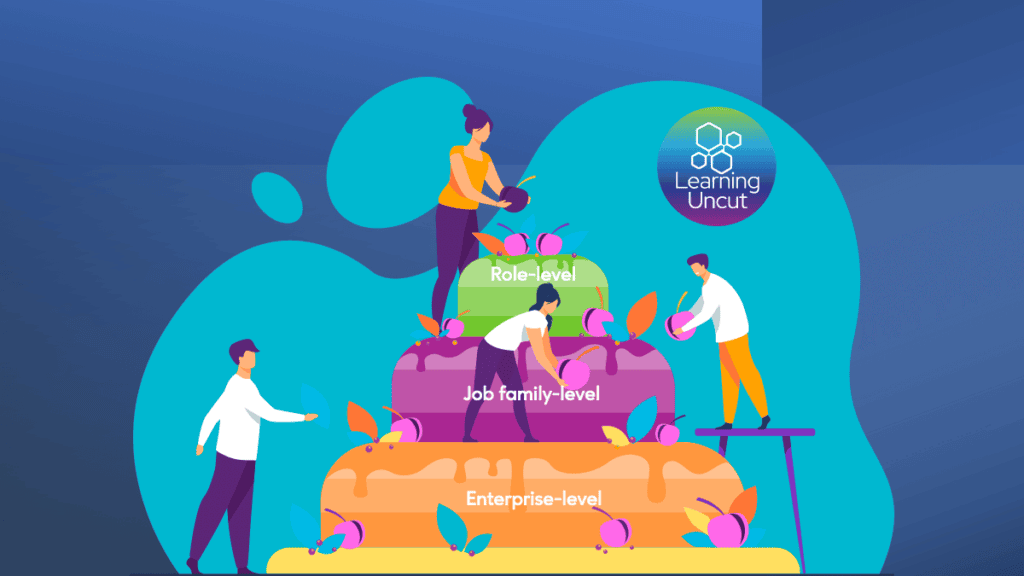Learning Uncut is addressing the gap in practical guidance on how to develop a high-impact organisational learning strategy. Our previous article introduced organisational learning strategy and outlined the key elements in a strategy. This article builds upon that by exploring common pitfalls that people fall into when creating a learning strategy.
What is an organisational learning strategy?
An organisational learning strategy is an overarching blueprint for learning in an organisation. It clarifies how learning supports achievement of the business strategy.
It is different from the strategy for a specific learning solution. Your organisational learning will inform the design of specific solutions or programs. It is also not a catalogue or inventory. It doesn’t list of specific capabilities, programs, or courses. These belong in your operational plans. Your strategy should be relatively enduring so that it can be applied to developing any set of capabilities or achieving a range of different business goals.
A learning strategy is similar in function to a house plan. Without a plan, your house may not meet your needs or support your vision for your lifestyle. It can also lack structural integrity. Similarly, a well-crafted learning strategy provides a strong framework to help you contribute to your organisation’s goals and strategy and coherently and consistently create business value over an extended period.
Pitfalls
There are some pitfalls or traps that people fall into when developing a learning strategy.

Copying
Strategy must fit your context. Look at examples from elsewhere with curiosity. Seek inspiration and ideas. Ask how other strategies fit the context of the organisation they were created for. However, do not copy someone else’s strategy. It won’t fit your organisation’s environment, circumstances, and people.

Apple Pie
Broad motherhood statements about learning will fail to move people to action. Move beyond theory to provide clear, concrete details in plain language about what learning looks like in your organisation. Spell out benefits to different stakeholders, and what they can do to achieve them. Make it actionable for all.

Ivory Tower
Have you ever been to a one-day strategy workshop which is stacked with people from learning and development? Perhaps some other human resources people have joined you. However, functions such as operations, production, customer service, technology and marketing were not invited – or are under-represented. It’s risky to create strategy in an ivory tower, in isolation of the people you serve. Your strategy will only represent your views and opinions. You run the risk of not addressing stakeholder needs or creating a deeply attractive and compelling strategy.

Blindfolded
We all have biases and assumptions, no matter how long we have been in an organisation. Like others with domain expertise, as learning professionals we are also prone to entrained thinking shaped by our experience of past successes. Conducting internal research improves your chances of seeing things as they really are in your organisation. Additionally, looking at industry trends, benchmarks and case studies helps you to identify new possibilities and take a more informed approach.

Outsourcing
Handing over strategy development to an external consultant may be expedient, but it is also risky. Developing an effective strategy requires deep thinking done in conjunction with your stakeholders. You want to hear first-hand, with empathy, about their needs and expectations. You want the opportunity to deepen relationships and generate buy-in with the strategy. Doing this work yourself, underpinned by a sound process, allows you to achieve these shifts – and enhances your credibility. Worst case, you may not understand the rationale for the strategy that the consultant hands over to you.
Beware of your bias to action
Underlying these pitfalls is our natural human orientation to take action which leads to:
- Moving too quickly
- Thinking too shallowly
- Failing to engage widely and deeply enough with your stakeholders
Our brains are wired for fast, efficient thinking. It brings us relief to makes decisions rather than sit uncomfortably with ambiguity and open questions. On top of this in many organisations there is a lot of pressure to be seen to be taking action. Yet this can lead us to work on solutions before we have a solid lay of the land.
Avoiding these pitfalls
Resist the pressure and temptation to move too quickly.
Reframe what action looks like. Investigation is action. Gathering and examining evidence is action. Doing some solid, structured thinking to overcome the myriad of cognitive biases and assumptions that will trip us up is action.
Take these steps with key stakeholders involved and they will see and feel that you are in motion.
In our next post we’ll look more closely at principles to help you avoid learning strategy pitfalls. Download our learning strategy checklist now if you’d like an advance look at these nine principles.
To set you up for success, we have distilled our deep hands-on experience into a robust process and set of tools in our Strategy Builder service.
To give L&D Leaders a taste of our approach we invite you to book in for a free Strategy Health Check. If you are an L&D leader who values constructive reflection, reviews, and recommendations, then this offering from Learning Uncut is for you!
Your Learning Strategy Health Check consists of:
- An online Health Check survey (30 mins)
- A review of your current learning strategy, informed by survey responses (45 mins)
- A summary report and suggested next steps
If you’re ready to access high-value support with your learning strategy from our experts use this link to book your Learning Strategy Health Check.


